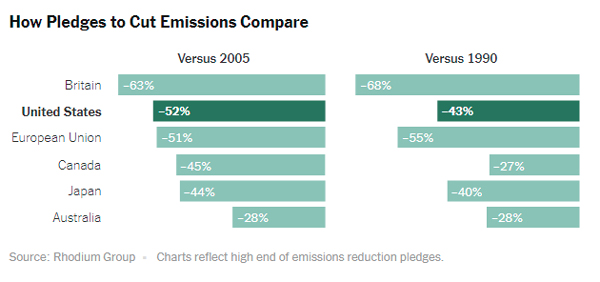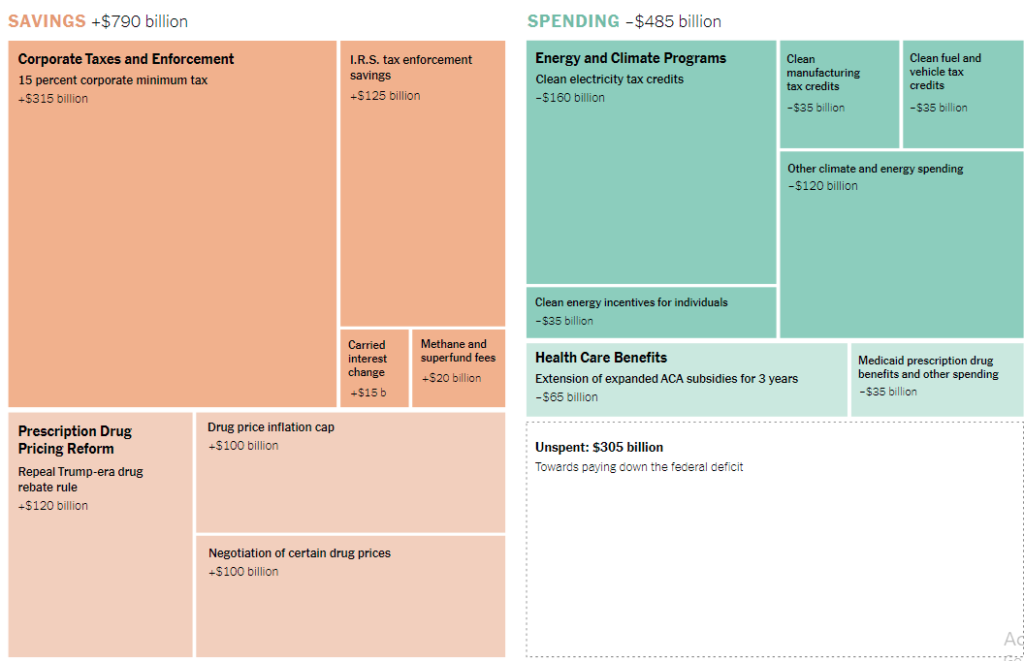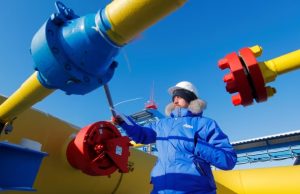
Nadja Popovich and Brad Plumer, NYtimes
NEW YORK/WASHINGTON
EnergiesNet.com 08 03 2022
A major climate and energy package announced last week in a deal by Senate Democrats would put the United States much closer to its goal of cutting global warming pollution in half by 2030, several new independent analyses have concluded.

If signed into law, the bill’s hefty tax incentives for low-carbon technologies could enable the country to cut its net greenhouse gas emissions by roughly 40 percent below 2005 levels by the end of this decade, according to forthcoming research by the Princeton-led REPEAT Project. While that falls short of President Biden’s goal to cut U.S. emissions by at least 50 percent below 2005 levels by 2030, experts said that additional policies like new federal regulations or more aggressive state and local climate action could help close the gap.
“This bill does about two-thirds of the work we need to do to hit our climate goals, which for a single piece of legislation is a really big deal,” said Jesse Jenkins, an energy systems engineer at Princeton who helped lead the modeling effort. “And by driving down the cost of clean energy, it can make it easier for states or cities or companies to take further climate actions on their own.”
Without the bill, emissions in the United States were already on track to fall roughly 26 percent from their peak in 2005 by the end of this decade, the researchers found. That’s partly because electric utilities have been closing down coal-fired power plants in favor of cheaper and cleaner natural gas, wind and solar power, and because Americans are starting to buy more electric vehicles, which typically create fewer emissions than gasoline-powered models.
The new bill would help accelerate the trend toward lower emissions in electricity and transportation, expanding tax credits for new wind turbines, solar panels, batteries and electric vehicles. But it would also invest billions in other technologies like advanced nuclear reactors, clean-burning hydrogen fuels, carbon capture and storage and electric heat pumps that could help curb emissions from heavy industry and buildings, two areas where the country has made little progress to date.
The REPEAT Project analysis is broadly in line with early estimates from analysts at Rhodium Group and Energy Innovation, two nonpartisan research groups that made public their own modeling over the past week.
Mr. Biden set a goal last year of cutting U.S. emissions in half by the end of this decade, which is roughly the pace scientists say the whole world must follow to limit global warming to 1.5 degrees Celsius (2.7 degrees Fahrenheit) above preindustrial levels in order to minimize the risk of catastrophic heat waves, wildfires, floods and droughts. Earth has already warmed roughly 1.1 degrees Celsius over the past century.
For the past two years, however, Democrats have struggled to get major climate legislation through the evenly divided Senate, where no Republicans support such a measure. One of the key Democratic holdouts, Senator Joe Manchin III of West Virginia, had said he could not vote for a fresh spending bill if it aggravated inflation, which hit a 40-year high in March.
A key breakthrough appeared to come last week, when Mr. Manchin announced that he would back a compromise measure. The bill, known as the Inflation Reduction Act of 2022, includes roughly $485 billion in new spending and tax breaks — most of that toward climate and energy programs, as well as smaller amounts for health care — which is offset by roughly $790 billion of tax increases and other savings, according to a preliminary estimate by the Committee for a Responsible Budget, a nonpartisan group.

“Rather than risking more inflation with trillions in new spending, this bill will cut the inflation taxes Americans are paying, lower the cost of health insurance and prescription drugs, and ensure our country invests in the energy security and climate change solutions we need to remain a global superpower,” Mr. Manchin said last week.
Economists and policy experts largely agree the bill could help mitigate inflation, although they cautioned that its effects may be moderate. They also noted that the roughly $300 billion in deficit payments over the next decade would put a relatively small dent in the overall debt of the United States.
Still, if the new legislation passes the House and Senate, it would be the largest climate investment ever made by Congress, amounting to roughly $385 billion over 10 years. Experts said the measure could provide fresh momentum to international climate talks and prod other nations to do more. It could also help reduce the cost of various clean-energy technologies, potentially making it easier for other countries to transition away from fossil fuels.
The bill will not solve global warming on its own. A United Nations report last year estimated that humanity will likely need to cut greenhouse gas emissions by an additional 15 to 30 billion tons by 2030, compared with its current trajectory, to avert the worst impacts of climate change. Mr. Jenkins’s analysis suggested the new Senate bill would supply nearly one billion tons of additional cuts.
“Assuming it passes, I think this clearly strengthens U.S. influence in the international talks and will spur further action by other major emitters,” said Dan Lashof of the World Resources Institute. “I think the history of climate action shows that when the United States makes a significant investment in clean energy technology, countries like China and India don’t want to be left behind.”
The legislation could transform nearly every aspect of American energy production. Mr. Jenkins’s analysis estimates that companies would install twice as much solar and wind power per year by 2030 as they would have without the bill. The bill would also offer incentives for utilities to keep their nuclear plants open for longer. Without that provision, as much as one-third of the nuclear fleet, still the nation’s largest source of low-carbon energy, is at risk of closing by 2030, Rhodium Group has estimated.
The bill would also give companies incentive to install devices to capture carbon dioxide from industrial facilities and bury it underground before the gas can escape into the atmosphere and heat the planet. While this technology has struggled to gain traction because of high costs, Mr. Jenkins’s modeling suggests that new tax credits could help spur the capture of roughly 200 million tons of carbon dioxide by 2030.
Calpine Corporation, a Houston-based firm that owns the nation’s largest fleet of natural gas power plants, has identified 11 facilities that are good candidates for retrofitting with carbon capture technology. The expanded tax credits could offer a significant boost in helping to get the first few projects up and running this decade, said Caleb Stephenson, Calpine’s executive vice president of commercial operations.
There are still uncertainties around the bill’s precise effects, however, in part because it does not require companies to cut their emissions. Much will depend on how quickly new low-emission energy sources displace coal, oil and natural gas, the major drivers of global warming. For example, if oil prices stay high, the tax credits for electric vehicles could spur consumers to ditch their gasoline-powered cars more quickly. But if gasoline gets cheap again, the transition might unfold more slowly.
And clean energy could face other hurdles: While the bill would give companies financial incentive to build more wind and solar power, such projects could be hobbled by local opposition or a lack of new transmission lines. The availability of tax credits for electric vehicles will depend on whether automakers can source their battery materials from the United States or its free-trade partners, which could be a difficult hurdle to clear.
The legislation also has several provisions that could increase emissions in some places. To secure the support of Mr. Manchin, the bill would mandate lease sales for new oil and gas exploration in the Gulf of Mexico and the Cook Inlet in Alaska. And it would require the Interior Department to hold auctions for fossil fuel leases if it plans to approve new wind or solar projects on federal lands.
But the impact of those measures is likely to be small. Analysts at Energy Innovation calculated that for each ton of emissions created by the leasing provisions, “at least 24 tons of emissions are avoided by the other provisions.”READ 19 COMMENTS
nytimes 08 02 2022












